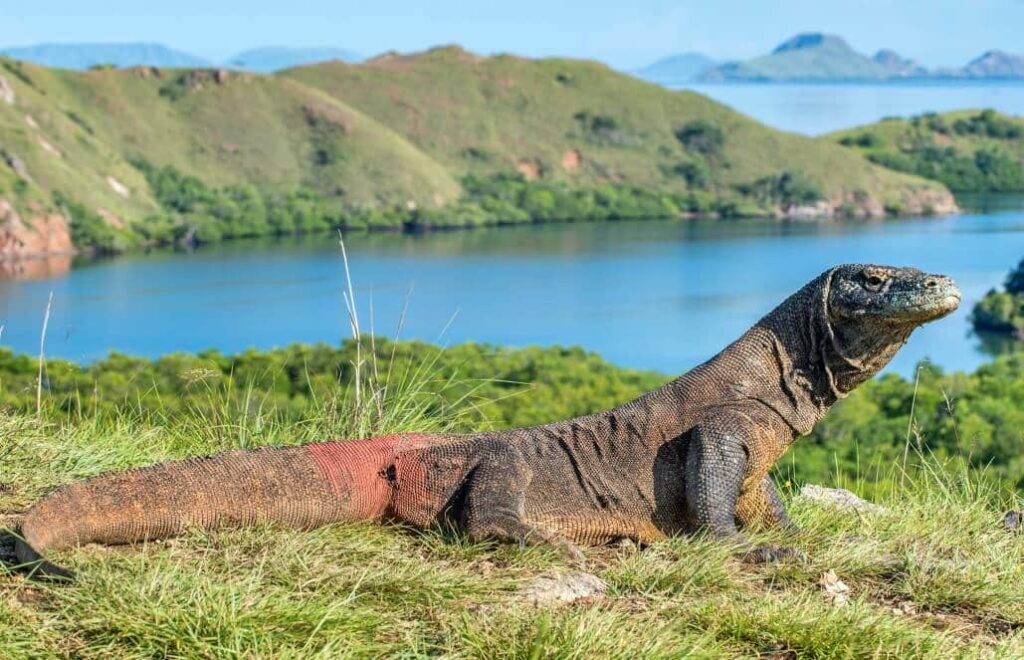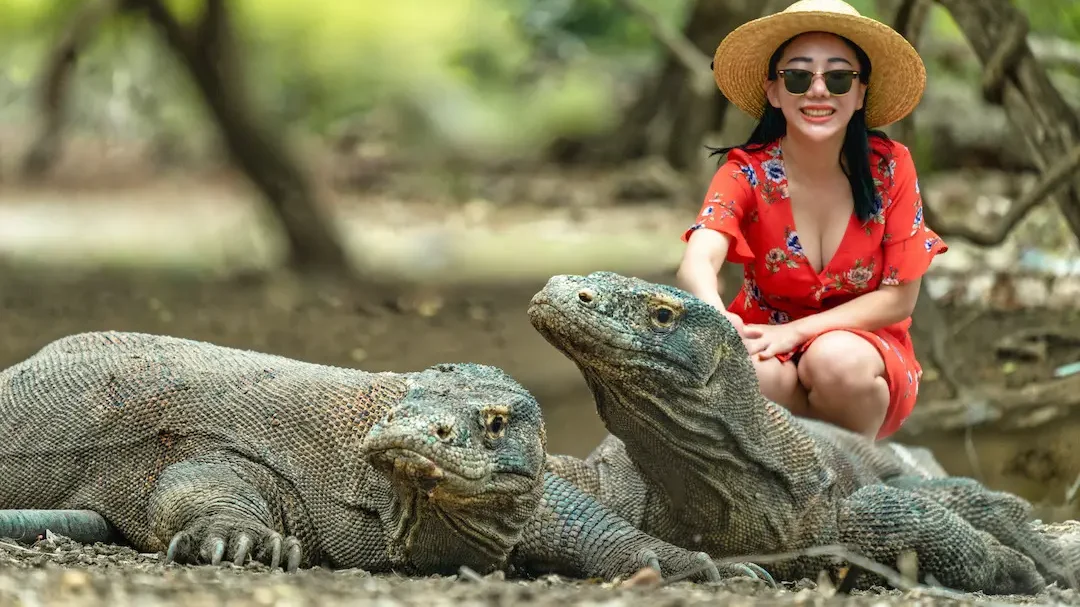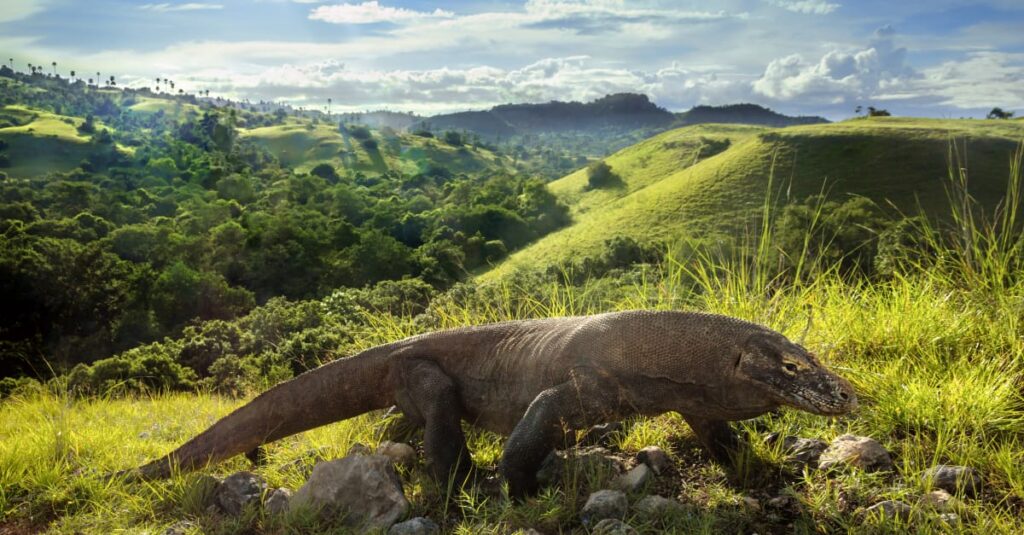Being the largest living lizard in the world, the Komodo dragon is an amazing and dangerous reptile that is well-known for its remarkable size, distinct features, and unique personality. Key details regarding the Komodo dragon are as follows:

1. Physical Appearance of Komodo Dragon
Komodo dragons can grow up to 150 pounds (70 kilograms) in weight and reach lengths of up to 10 feet (3 meters).

- Their skin is scaly and rough, with shades ranging from grey to brown.
- Their forked yellow tongue, which they use to detect and find prey, is a distinguishing
- Dimensions and Structure:
- Length: Weighing more than 70 kg (150 lbs) and growing to a maximum height of 3 meters (10 ft), these are genuinely enormous lizards.
- Body: With a long, flat head, short limbs, and a thick tail that can reach the length of their body, adults have a robust build. Younger people are more nimble and lean.
- Skin: They have big, tough scales covering their skin, which can be olive green, brown, or grey in color. On their faces, there are frequently yellowish-green patches. The flanks of adult females may have a crimson hue.
- Head and oral cavity
- Head: The head is large and flat, with a rounded snout and strong jaws that can hold teeth up to 2.5 cm (1 inch) long that are serrated.
- Tongue: Their ability to smell their prey is greatly enhanced by their forked tongue, which flicks in and out.
2. Habitat
Komodo, Rinca, Flores, Gili Motang, and a few other smaller Indonesian islands are the homes of Komodo dragons.
Komodo, Rinca, Gili Motang, Gili Dasami, and Padar are the five islands that makeup Komodo National Park, which serves as the primary habitat for most Komodo dragons.
Flores: The western part of Flores Island has a smaller number of Komodo dragons, despite not being part of the National Park.
The dragons are not limited to any one kind of environment on these islands. They are incredibly adaptable and can be found in a range of environments, such as:

A large portion of their range is made up of dry, open grassland, which provides areas for hunting and sunbathing.
Savanna: Like grasslands, savannas have wide spaces interspersed with trees that give shade and sunlight.
Tropical Forests: Although not their ideal environment, they can be found in arid, low-lying forests; this is especially true for juvenile dragons, who use the trees as a means of protection from predators.
Volcanic Slopes: Komodo dragons are adept at navigating the rocky slopes and arid scrubland found on several of the islands in their habitat, including Rinca and Komodo.
In summary, the Komodo dragon inhabits a variety of arid, open habitats, including grasslands, savannas, and even some dry forests, and is dispersed throughout a few Indonesian islands, mostly inside Komodo National Park. Their ability to adapt lets them flourish in these varied environments.
3. Diet
Being carnivores, their main sources of nutrition are living prey like birds, mammals, and other reptiles, as well as carrion, or dead creatures. As sly hunters, komodo dragons have been observed to take down huge game such as water buffalo and deer.

Changes in Diet Throughout Life:
Hatchlings Begin Small: Newly emerged Komodo dragons are considerably smaller and more delicate than mature dragons. Their primary food is insects, small lizards, and bird eggs; as they get bigger, they start consuming larger prey.
Adults Take on Big Game: Komodo dragons can now handle larger games because they are stronger and larger as they get older. When they reach adulthood, Javan rusa deer, along with other large mammals like goats and pigs, become popular pets.
4. Venom and Bacteria
Although their poison is typically not fatal, Komodo dragons have venom glands in their lower jaw. The true danger comes from the germs in their mouths, which can infect their victims fatally.
5. Hunting Strategies of Komodo Dragon
The patient predators, known as Komodo dragons, are known to pursue their prey for several hours before launching a devastating attack. Once they have their victim, they usually wait for the animal to die from wounds or bacteria in their saliva.

A. Masters of Ambush:
Komodo dragons are the masters of camouflage, blending in well with their rocky, arid environments. To unwary victims, their mottled green and brown scales virtually blend in with the surrounding plants and rocks.
B. Opportunistic Prowlers:
Patient Stalkers: Komodo dragons are incredibly patient animals that may frequently wait for hours next to game tracks or water holes. When the time is right, their strong legs enable them to accelerate quickly.
C. The Deceptive Bite and Wait:
Their blade-like, serrated teeth cause deep cuts, making them a deadly weapon. Their poisonous saliva, which contains a concoction of chemicals that cause blood clotting, reduce blood pressure, and paralyse muscles, is the true game-changer, though. Even though it is not killed right away, the prey deteriorates over several hours, making it easier for the Komodo dragon to locate and consume it.
6. Reproduction
Nests dug into the ground are where female Komodo dragons lay their eggs. They are capable of laying up to thirty eggs at once. The mother looks after the eggs during their several-month incubation period.
7. Conservation Status
The International Union for Conservation of Nature’s (IUCN) Red List has Komodo dragons listed as vulnerable. In an effort to save their numbers and habitats, conservation initiatives have been implemented.
8. Tourism
One well-liked tourism spot where travelers can see these animals in their native environment is Komodo National Park.

9. Myth and Legend
These animals are frequently portrayed in local tradition as terrifying and legendary beings on the Komodo Islands.
10. Evolutionary Significance
Because they are the largest remaining members of their ancient family, the Varanidae, which has existed for millions of years, Komodo dragons are frequently referred to as living fossils.
Because of these details, the Komodo dragon becomes an interesting object of study and observation, illustrating the diversity of life on Earth and the special adaptations that have allowed the species to flourish in its particular environment.
Read more about the Dinosaurs
Read more about the Top 10 World’s Fastest Animals on Land.
Follow us on social media
